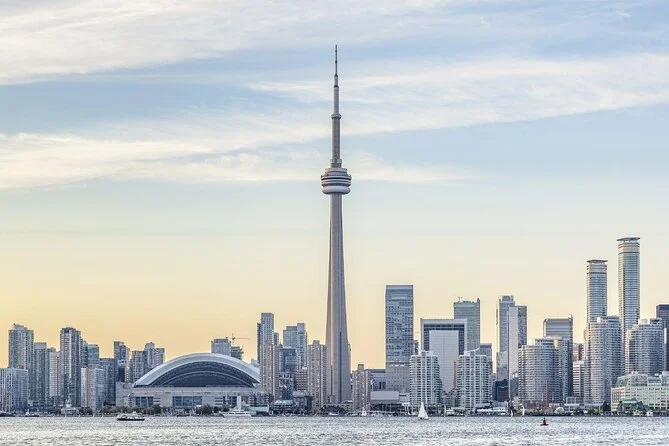
The CN Tower, an iconic landmark in Toronto, Canada, stands as a testament to engineering brilliance and architectural innovation. Since its completion in 1976, it has captivated visitors from around the world with its towering height and breathtaking views. This impressive structure not only serves as a major tourist attraction but also plays a crucial role in telecommunications and the local economy. Here are some fascinating facts about the CN Tower that highlight its significance and enduring appeal.
Height: Standing at a height of 553.33 meters (1,815.3 feet), the CN Tower is the 7th tallest freestanding structure in the world as of 2024. This impressive height makes it an iconic feature of Toronto’s skyline and a remarkable achievement in engineering and architecture. The tower’s height was intentionally designed to surpass that of other tall structures of the time, aiming to make a bold statement. Its towering presence is not only a symbol of Toronto but also a significant landmark visible from miles away. The height of the CN Tower allows it to serve multiple purposes, including telecommunications, observation, and entertainment.
Concrete Used: The construction of the CN Tower required over 45,000 cubic meters (1,600,000 cubic feet) of concrete, which is enough to fill 18 Olympic-sized swimming pools. This massive amount of concrete was necessary to create the sturdy base and core of the tower, ensuring its stability and durability. The concrete used in the tower’s construction was specially formulated to withstand extreme weather conditions and the stress of the tower’s height. The use of such a large quantity of concrete highlights the scale and complexity of the project, reflecting the careful planning and engineering required to complete one of the world’s tallest freestanding structures.
Weight: The CN Tower weighs approximately 130,000 metric tons (143,000 tons), which is roughly equivalent to the weight of 20,000 elephants. This immense weight is distributed across the tower’s foundation and core, providing the necessary support to keep the structure upright and stable. The weight includes all the materials used in construction, such as concrete, steel, and the various fixtures and fittings within the tower. The substantial weight also contributes to the tower’s ability to withstand strong winds and seismic activity, ensuring its longevity and safety for visitors and those who rely on it for telecommunications.
Construction Cost: The construction of the CN Tower cost $63 million CAD ($50 million USD) in 1976, which, when adjusted for inflation, translates to roughly $300 million CAD ($230 million USD) in 2024 dollars. This substantial investment reflects the ambitious nature of the project and the cutting-edge technology and materials used in its construction. The cost covered not only the physical building of the tower but also the extensive planning, engineering, and labor required. The significant expenditure was justified by the tower’s role in enhancing telecommunications infrastructure and its eventual status as a major tourist attraction, contributing to Toronto’s economy.
Number of Floors: The CN Tower has a total of 147 floors, although the majority are dedicated to mechanical equipment and are not accessible to the public. These floors house essential infrastructure such as elevators, power systems, and telecommunications equipment, which are critical for the tower’s operation. The public-accessible floors include observation decks, the revolving 360 Restaurant, and various event spaces. The design of the tower’s floors reflects a careful balance between functional and recreational spaces, maximizing its utility while offering visitors spectacular views and unique experiences.
Official Opening: The CN Tower was officially opened on July 26, 1976, by Queen Elizabeth II. This grand opening ceremony marked the culmination of years of planning and construction and was a significant event in Canadian history. The presence of the Queen at the opening underscored the tower’s importance and its status as a national landmark. The official opening was attended by dignitaries and officials and was widely covered in the media, bringing international attention to the tower. The opening of the CN Tower symbolized a new era of technological advancement and architectural innovation for Canada.
Architects: The CN Tower was designed by a team that included Canadian architects John C. Parkin and Eberhard Zeidler, along with structural engineer Fazlur Khan. These professionals brought together their expertise in architecture and engineering to create a structure that was both aesthetically pleasing and structurally sound. John C. Parkin was known for his modernist designs, while Eberhard Zeidler contributed innovative architectural ideas. Fazlur Khan, a pioneer in structural engineering, provided the technical expertise needed to ensure the tower’s stability and safety. Their collaboration resulted in a landmark that has stood the test of time and continues to be celebrated for its design and engineering excellence.
World’s Tallest Title Held: From 1976 to 2010, the CN Tower held the title of the world’s tallest freestanding structure for 34 years. This record-setting achievement brought international acclaim to the tower and to Toronto. Holding the title for such an extended period highlighted the tower’s advanced engineering and design, as well as the ambition behind its construction. The tower’s height was eventually surpassed by other structures, but its legacy as a former record holder continues to enhance its prestige and attract visitors. The long-standing record contributed to the CN Tower’s reputation as a marvel of modern engineering and architecture.
Gust Wind Speed Recorded: In 1978, the CN Tower recorded gust wind speeds of 243 kilometers per hour (151 mph), demonstrating its ability to withstand extreme wind conditions. This remarkable wind resistance is due to the tower’s tapered design and strong concrete core, which provide stability and reduce sway. The tower’s engineers designed it to endure high wind speeds and other environmental stresses, ensuring its safety and durability. The ability to withstand such powerful winds without structural damage is a testament to the meticulous engineering and construction techniques used in building the tower.
Antenna Length: The antenna mast on the CN Tower measures 102 meters (335 feet), adding to its overall height and functionality. This antenna is a critical component for the tower’s role as a telecommunications hub, transmitting radio, television, and cellular signals throughout the Toronto area. The height of the antenna ensures clear signal transmission over long distances, making it an essential part of the city’s communications infrastructure. The design and installation of the antenna required precise engineering to ensure it could withstand the same environmental conditions as the rest of the tower. The antenna’s length also contributes to the tower’s iconic silhouette, enhancing its prominence in the Toronto skyline.
Revolving Restaurant: The CN Tower’s 360 Restaurant completes a full revolution every 72 minutes, providing diners with panoramic views of Toronto as they enjoy their meals. This unique dining experience combines fine cuisine with breathtaking vistas, making it a popular attraction for both tourists and locals. The restaurant’s rotation is smooth and slow enough that patrons often do not notice the movement, allowing them to focus on the spectacular scenery. The revolving mechanism is an engineering marvel, seamlessly integrating with the tower’s structure. The 360 Restaurant offers a variety of dishes, emphasizing local ingredients and culinary excellence, which, combined with the ever-changing view, creates a memorable dining experience.
Glass Floor: The CN Tower’s Glass Floor observation deck, located 342 meters (1,122 feet) above the ground, offers a thrilling experience for visitors. The Glass Floor allows guests to look straight down, providing a unique and exhilarating perspective of the city below. This feature is designed to withstand substantial weight and stress, with each panel capable of holding the equivalent of 14 large hippos. The Glass Floor’s introduction added a new dimension to the tower’s attractions, inviting visitors to overcome their fears and enjoy a one-of-a-kind view. The engineering behind the Glass Floor ensures safety and durability while offering an unparalleled visual experience.
EdgeWalk: Opened in 2011, the EdgeWalk at the CN Tower is an adrenaline-pumping attraction where visitors can walk hands-free along a 1.5-meter (5-foot) wide ledge outside the tower’s main pod, 356 meters (1,168 feet) above the ground. Participants are secured with a harness system, allowing them to lean out over the edge and experience the thrill of open-air heights. EdgeWalk is the world’s highest full-circle, hands-free walk, offering spectacular views of Toronto and Lake Ontario. This extreme adventure attracts thrill-seekers from around the globe and has become one of the tower’s most popular attractions, providing a unique combination of excitement and breathtaking scenery.
Highest Public Viewing Platform: The SkyPod observation deck is situated at a staggering 447 meters (1,467 feet) above the ground, making it the highest public viewing platform at the CN Tower. This deck offers 360-degree views, allowing visitors to see up to 160 kilometers (100 miles) away on a clear day, including views of Niagara Falls and New York State. The SkyPod provides an unparalleled vantage point for observing the city and its surroundings, making it a highlight for many visitors. The journey to the SkyPod involves a thrilling elevator ride, which in itself is an experience as it ascends rapidly, offering glimpses of the city through glass panels.
Number of Visitors Annually: The CN Tower attracts over 1.2 million visitors each year, solidifying its status as a major tourist attraction in Toronto. This steady influx of tourists contributes significantly to the local economy, supporting businesses such as hotels, restaurants, and shops. The tower’s wide range of attractions, including the observation decks, EdgeWalk, 360 Restaurant, and special events, ensures there is something for everyone. The tower’s appeal extends beyond its height and views; it also serves as a symbol of Toronto, drawing visitors who want to experience one of Canada’s most iconic landmarks.
Longest Exterior Staircase: The CN Tower features the longest exterior staircase in the world, with 1,776 steps leading from the bottom floor to the top. This staircase is primarily used as an emergency exit but also hosts an annual charity stair-climb event, where participants challenge themselves to reach the top. The stair-climb event attracts thousands of participants each year, raising funds for various causes while promoting fitness and community spirit. Climbing the stairs provides a unique perspective of the tower’s structure and an intense physical challenge, making it a memorable experience for those who undertake it.
Communication Hub: The CN Tower functions as a vital communication hub for Toronto, transmitting radio, television, and cellular signals. Its height and central location make it an ideal site for broadcasting, ensuring clear and uninterrupted signal transmission throughout the region. The tower’s infrastructure supports multiple broadcasters and telecommunication providers, playing a crucial role in the city’s communication network. The design and maintenance of the tower’s communication equipment are critical to its operation, requiring regular updates and inspections to keep up with technological advancements and ensure reliable service.
Weather Monitoring Station: At the top of the CN Tower, meteorological instruments collect valuable data on wind speed, temperature, and humidity. This information is crucial for weather forecasting and research, providing insights into weather patterns and climate conditions in the region. The tower’s height allows it to gather data from a unique vantage point, contributing to a better understanding of atmospheric conditions. The weather monitoring station at the CN Tower is an essential tool for meteorologists and researchers, helping to improve the accuracy of weather predictions and contributing to scientific studies related to climate and weather.
Light the Night: The CN Tower’s exterior lights can change color for various occasions and holidays, creating a dazzling spectacle at night. This lighting system allows the tower to celebrate significant events, support causes, and engage with the community through vibrant light displays. The lighting can be customized to show different colors and patterns, making the tower a focal point during celebrations such as Canada Day, Pride Month, and other important events. The ability to light up the tower in various ways adds to its iconic status and enhances its role as a symbol of Toronto’s spirit and diversity.
Canadian National (CN) Tower: The name “CN Tower” originates from the Canadian National Railway, which funded a significant portion of the construction costs. Originally built as a communications and observation tower, it was intended to demonstrate the strength and capability of Canadian industry and technology. The involvement of the Canadian National Railway underscores the tower’s importance as a national project and a symbol of Canadian ingenuity. Over time, the CN Tower has evolved from its industrial roots to become a beloved landmark and major tourist attraction, reflecting its versatility and enduring appeal.
Original Nickname: During its construction, the CN Tower was nicknamed “The Monster of the Midway” due to its massive scale and the ambitious nature of the project. This nickname captured the public’s awe and curiosity about the towering structure rising above Toronto’s skyline. The moniker reflected both the engineering challenges involved and the impressive feat of constructing such a monumental building. As the tower neared completion, the nickname faded, and it became widely known by its official name, the CN Tower, symbolizing its transformation from a construction marvel to an iconic landmark.
Almost Twice as Tall: The original proposal for the CN Tower called for a height of 338 meters (1,109 feet), but the design was ultimately doubled to make a more iconic statement. This decision was driven by the desire to surpass other tall structures of the time and to establish the tower as a symbol of innovation and progress. The increased height required significant engineering advancements and the use of cutting-edge construction techniques. Doubling the proposed height not only set new records but also ensured the tower’s place as a global architectural icon, attracting visitors from around the world.
Seven Wonders of the Modern World: In 1999, the CN Tower was shortlisted for inclusion in the “Seven Wonders of the Modern World” competition. This recognition highlighted the tower’s architectural and engineering significance, placing it among other contemporary marvels. Although it did not make the final list, being considered for this prestigious accolade underscored the tower’s impact and importance. The competition brought additional attention and prestige to the CN Tower, further solidifying its status as a must-see attraction and a testament to modern engineering and design excellence.
Toronto’s Tallest Building: While the CN Tower is no longer the world’s tallest freestanding structure, it remains the tallest structure in Toronto. Its dominance over the city’s skyline is unmistakable, providing a focal point that can be seen from various points throughout the city. The tower’s height and distinctive design make it a defining feature of Toronto, contributing to the city’s identity and charm. As Toronto continues to grow and develop, the CN Tower retains its status as the most prominent and recognizable structure, symbolizing the city’s architectural ambitions and achievements.
Economic Impact: The CN Tower is a significant economic driver for Toronto, generating substantial revenue from tourism, restaurants, and event spaces. The influx of over 1.2 million visitors annually contributes to local businesses, including hotels, shops, and transportation services. Special events and attractions within the tower, such as the EdgeWalk and 360 Restaurant, provide additional economic benefits. The tower’s role as a major tourist destination helps boost Toronto’s economy, supporting jobs and encouraging investment in the city’s hospitality and service industries. Its economic impact underscores the tower’s importance beyond its architectural significance, highlighting its role in the city’s financial well-being.
5 Frequently Asked Questions About the CN Tower:
What is the CN Tower used for?
The CN Tower serves multiple purposes:
Observation Deck: The primary function is as a tourist attraction with breathtaking observation decks offering panoramic views of Toronto. The SkyPod observation deck, at 447 meters (1,467 ft), is the highest public viewing platform in Canada.
Communication Hub: The CN Tower is a vital communication hub for Toronto, transmitting radio, television, and cellular signals for a vast area.
Restaurant: The 360 Restaurant, a revolving restaurant, allows diners to enjoy a full meal while taking in the ever-changing views of the city.
Entertainment: The CN Tower offers various entertainment experiences, including the thrilling EdgeWalk (walking hands-free on a ledge outside the tower) and unique event spaces.
Weather Monitoring: Meteorological instruments at the top of the tower collect valuable weather data, assisting weather forecasting for the region.
How tall is the CN Tower, and is it still the world’s tallest?
The CN Tower stands at an impressive 553.33 meters (1,815.3 ft) tall. While it held the title of the world’s tallest freestanding structure for 34 years (1976-2010), it is currently the 7th tallest.
What are some of the activities you can do at the CN Tower?
The CN Tower offers a variety of activities for visitors:
Observation Decks: Enjoying the breathtaking views of Toronto from various observation decks, including the thrilling Glass Floor with a see-through section.
360 Restaurant: Experiencing a unique dining experience at the revolving restaurant while taking in panoramic views.
EdgeWalk: For the adventurous, attempting the exhilarating EdgeWalk, a hands-free walk on a ledge outside the tower with a safety harness system.
Special Events: The CN Tower frequently hosts special events throughout the year, like light shows and themed experiences.
Is it safe to visit the CN Tower during strong winds?
The CN Tower is designed to withstand extreme weather conditions. The record wind speed ever measured at the tower was 243 kilometers per hour (151 mph) in 1978, demonstrating its structural integrity. The tower closes to the public only in exceptionally high winds for safety reasons.
How much does it cost to visit the CN Tower?
The cost of visiting the CN Tower varies depending on the experience you choose:
General Admission tickets provide access to various observation decks, including the Glass Floor.
Additional fees apply for experiences like EdgeWalk and the 360 Restaurant.
Discounted rates are often available for children, seniors, and groups.
It’s recommended to check the CN Tower’s website for current pricing and ticketing options before your visit.









